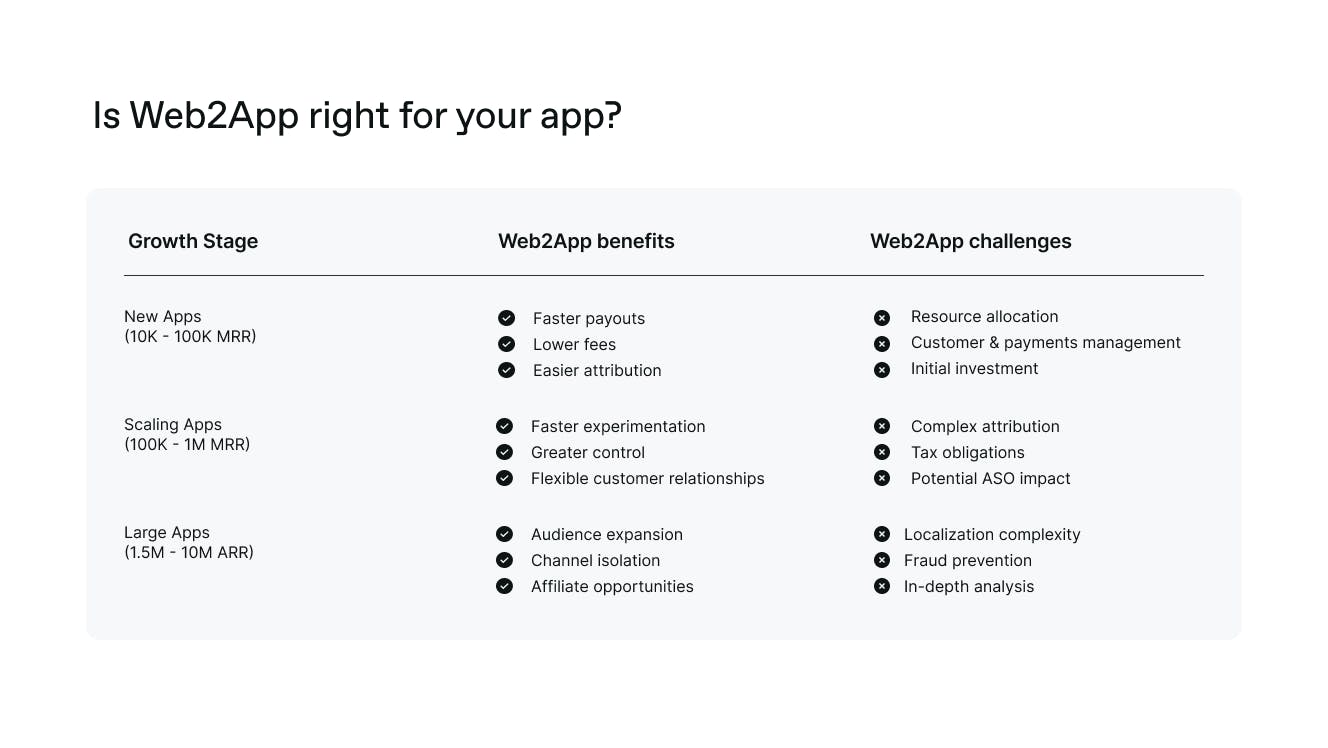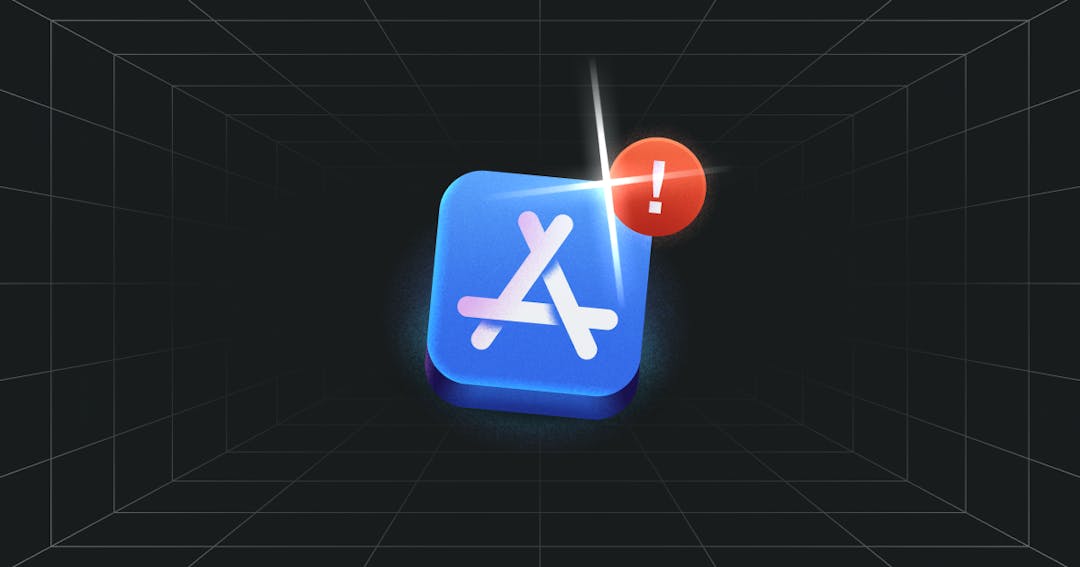You’ve encountered a Web2App funnel even if you haven’t realised it.
Whether following an Instagram link or clicking on a Google ad, the Web2App funnel directs traffic from social media and search engines to web-versions of popular mobile apps.
Why? With billions of web users, no marketing restrictions and no app store fees, Web2App strategies can unlock significant growth for app companies.
As part of our Web Revenue Labs series, Nathan Hudson, CEO of Perceptycs and 2024 App Marketer of the Year, sat down with Paddle CMO, Andrew Davies, to deep dive into the business case for Web2App in 2025.
In this playbook, Nathan gives you an in-depth breakdown of the benefits and challenges of setting up Web2App at each stage of growth.
Watch the full webinar here or dive into the playbook below.
What is a Web2App funnel and why does it matter?
Web2App refers to the process of converting traffic on the web or starting to convert traffic on the web before directing them to your app. If you’re using a web browser or your website as part of your conversion funnel, then it’s a Web2App funnel.
Web2App didn’t emerge to circumvent app store fees. Its origins are rooted in addressing attribution challenges following Apple's privacy changes.
When Apple introduced ATT and launched SKAdNetwork, developers struggled to optimize paid acquisition.
Web2App offered an attractive alternative: by capturing traffic and initiating onboarding and payment on the web, developers could avoid the complexity of privacy thresholds and delayed postbacks.
Learn more about other mobile app monetization strategies here
Best apps for Web2App
• Lifestyle apps (health, fitness, dating, etc.)
• Content-based apps (books, movies, music, etc.)
• Language learning apps
• Reader apps
The Typical Web2App Funnel
The standard Web2App approach follows this structure:
- Traffic Source: Users come in from various online channels (Meta, TikTok, Google Ads, etc)
- Landing Page: Users learn about product benefits or explore pain points.
- Web Onboarding: Users complete a survey/quiz and make a payment (or start a free trial).
- App Store: Users are directed to download the app.
But that’s not the only approach. Innovative app companies have tinkered with each stage of the funnel, such as:
- Skipping the landing page and taking users directly from ads to a quiz.
- Onboarding users on web but having them convert within the app.
- Using webinar funnels or product demonstrations instead of quizzes.
Is Web2App allowed under Apple’s T’s & C’s?
One of the most common concerns about Web2App is its compatibility with Apple's terms and conditions. There are different rules depending on where your app’s users are based and what type of app you have. Here's what you need to know.
What is allowed?
Running web acquisition funnels: You can acquire users on the web and send them to a web web checkout before directing them to download your app.
Email marketing to app users: You can email users who have created an account in your app to inform them they can purchase on your website, potentially at a better price, as long as this doesn't happen within the app session.
Marketing channels outside the app: You can use any marketing channels (social media, search, etc.) to direct users to your web experience rather than directly to the App Store.
What about the recent Epic v. Apple ruling in the US?
Thanks to a legal ruling in April 2025, all apps on the US Apple App Store can now include links to external web payments without incurring any of Apple’s fees. This is known as App2Web as you are acquiring users initially in the App Store then directing to the web to take a payment.
App developers are allowed to:
- Include buttons, external links, or other calls to action for web payments in their app
- Communicate with users about outside payment options
- Take external payments without paying any fees to Apple
Read more about this here
What does this mean for app developers outside the US?
As of June 2025, the US court ruling only applies to apps on the US App Store. Apps in the EU App Store can also use alternative payment methods on the web. However, you’ll still need to pay Apple 17% (or 10% for smaller apps) + 3% payment processing fee.
But it’s important to note that Web2App is still a viable option for all apps, no matter where they sell.
Can I really trust these new changes?
Even after the ruling, some developers we’ve spoken to are cautious to engage with external payments, fearful of App Store penalties.
But Apple execs are (potentially) facing criminal proceedings after violating a 2021 ruling, and could face prison time if the same judge believes they are still acting in bad faith later down the line.
Additionally, Apple had their appeal to pause external payments momentarily rejected by a U.S appeals caught on June 4th. It is therefore highly unlikely Apple will punish any app making the most out of this newfound opportunity.
Benefits analysis: Web2App funnels across growth stages
The benefits of Web2App vary depending on your app's growth stage. Here's a detailed breakdown:
For new apps ($10K-$100K MRR)
1. Reduced payback period
- Access revenue quicker than app stores (Apple can hold your money for up to 60 days vs 7-30 days for web payment options).
- Improved cash flow for testing and growth (critical for bootstrapped apps that rely on reinvesting revenue).
2. Lower fees
- Pay 5-10% to web payment solutions instead of 15-30% to app stores.
- Improve unit economics, especially for higher-priced subscriptions.
3. Easier attribution
- Easily track and analyze user acquisition efforts.
- Don’t worry about SKAdNetwork limitations or privacy thresholds.
- Use standard web analytics and conversion tracking tool.
For Scaling Apps ($100K-$1M MRR)
1. Faster experimentation
- Test onboarding flows, paywalls, and pricing quicker on web.
- Implement changes in hours vs waiting weeks for app store approvals.
- Rapidly iterate and optimize.
2. Greater control
- Customize user journeys without app store restrictions.
- Position pricing, implement features, and design experiences freely.
- Avoid app store policy limitations and guidelines.
3. Flexible customer relationships
- Implement smart refund policies, upsells, and winback campaigns.
- Communicate with customers without platform intermediaries.
- Create tailored retention and engagement strategies.
For Large Apps ($1.5M-$10M ARR)
1. Audience expansion
- Reach new users through web-specific channels and campaigns (there are 9.1 billion web users vs 650 million weekly App Store visitors).
- Access audiences that might not be targetable through app-only acquisition.
2. Channel isolation
- Scale individual channels like YouTube or Google Search independently.
- Test and optimize specific marketing channels without platform limitations.
- Get more granular control over campaign performance.
3. Affiliate Opportunities
- Easily manage and attribute affiliate partnerships on the web.
- Build referral systems and partnership programs with better tracking.
- Create new revenue streams through partnership channels.
Real-world Web2App funnel examples
Paddle's show, Fix That Funnel, breaks down the Web2App funnels of top mobile apps with expert insights, actionable takeaways, and real-world growth strategies.
Check out the episodes:
Web2App challenges and solutions
While the benefits are compelling, implementing Web2App comes with challenges. Here's how to address them:
Challenge 1: Resource allocation
Problem: Additional development time and costs for web funnel creation can strain limited resources.
Solution:
Begin with simple tools like Typeform for onboarding and integrate with existing website platforms. Start with a minimal viable implementation to test the concept, then gradually increase investment as you validate the approach. Also, consider no-code or low-code solutions for faster implementation.
Challenge 2: Customer and payments management
Problem: Handling refunds, chargebacks, and payment disputes directly falls on your team.
Solution:
Use a Merchant of Record (MoR) solution like Paddle that handles all these responsibilities. If you decide to take these on yourself, then be sure to implement clear policies for customer support and payment issues. Create automated systems for common customer requests. Balance the cost of payment processing against the backend services provided.
Challenge 3: Attribution complexity
Problem: Tracking cross-platform user journeys and conversions becomes more difficult.
Solution:
Implement cross-platform analytics tools like Amplitude or Mixpanel and run incremental tests to understand true channel performance. Create a consistent user identifier across platforms where possible and focus on outcome metrics (revenue, LTV) rather than just funnel metrics.
Challenge 4: Tax obligations
Problem: Managing varying sales tax laws across multiple regions and countries can be overwhelming.
Solution:
Partner with a service provider that handles global tax compliance. You could also start with core markets before expanding globally, but this would slow your growth. Consulting with tax specialists for high-volume markets is another approach, but again, the liability falls on you for managing sales taxes.
Challenge 5: Potential ASO impact
Problem: If you shift too much traffic to the web, your App Store ranking will fall due to lower install volumes.
Solution:
Balance direct app store installations with web traffic and be sure to continue investing in App Store Optimization (ASO) alongside web funnel efforts. Use app-specific campaigns to maintain install volume and implement strategies to encourage ratings and reviews.

Implementing a Web2App funnel strategy
Setting up Web2App can take anywhere between 24 hours to 6 weeks. To successfully implement Web2App, follow this structured approach:

1. Start Small
- Begin with a simple landing page to test web conversion rates.
- Use tools like Typeform or similar services to create initial onboarding flows.
- Focus on one market or audience segment first.
- Set clear success metrics before scaling.
2. Gradual Shift
- Slowly move budget from direct-to-app to web funnels to avoid disruption.
- Run incrementality tests to understand true performance.
- Don't abandon app store campaigns that are working well.
- Look for signals that indicate when to increase web investment.
3. A/B Testing
- Continuously test different web funnel variations to optimize performance.
- Compare web versus app conversion rates across the entire funnel.
- Test different traffic sources, landing pages, and onboarding experiences.
- Optimize based on revenue outcomes, not just conversion rates.
4. Monitor Metrics
- Closely track key performance indicators across both web and app.
- Compare retention and LTV between web-acquired and app-acquired users.
- Look for differences in trial conversion and renewal rates.
- Be prepared for surprises in long-term metrics.
Key considerations before implementation
Before diving into Web2App, assess these critical factors:
Market fit
- Evaluate if your product and audience are suitable for web funnels.
- Health and fitness, education, and language learning apps often see the best results.
- Utility apps and simple tools may benefit less from complex web onboarding.
User experience
- Ensure a smooth transition from web to app for your users.
- Mirror your in-app experience in the web funnel.
- Optimize for mobile web, not desktop (web funnels acquire users through mobile 90% of the time).
- Include multiple payment options to maximize conversion.
Ensure that you have as many different options and localized payment solutions as possible for your audience. Don't just account for credit cards if you're targeting the US. You need credit card, PayPal, Apple Pay, Google Pay.
Performance metrics
- Compare web vs. app conversion rates and profitability
- Account for differences in renewal rates and long-term retention
- Consider the total cost, including development, maintenance, and payment processing
- Look beyond the simple comparison of fees (3-6% vs. 15-30%) and consider the ‘hidden fees’ of integrating a web payments stack
Tools for Web2App funnels
- Landing page builders: Unbounce, Instapage, or even Typeform.
- Analytics platforms: Implement cross-platform tracking with tools like Amplitude or Mixpanel.
Payment solutions: Integrate secure payment options with services like Paddle.

Is Web2App right for your app?
The Web2App approach offers significant advantages for most app businesses, but the optimal implementation depends on your growth stage and specific circumstances:
For new apps (10K-100K MRR):
Focus on Web2App when expanding beyond app store advertising to improve cash flow and reduce payback periods. Start with simple implementations to validate the concept before significant investment.
For scaling apps (100K-1M MRR):
Implement Web2App to accelerate experimentation and gain greater control over the user journey. Balance web and app acquisition to maintain ASO performance while benefiting from web flexibility.
For large apps (1.5M-10M ARR):
Use Web2App to expand audience reach and control the user journey across multiple channels. Develop sophisticated cross-platform strategies that leverage the strengths of both web and app environments.
Remember: it’s not either Web2App or the App Store. It’s about finding the right balance. Most successful apps will maintain both channels, optimizing each for its strengths.
Next steps: Your Web2App implementation plan
- Assess Your Readiness: Evaluate if Web2App aligns with your current growth stage and resources
- Plan Your Strategy: Determine what type of funnel to build and how it integrates with your existing acquisition approach
- Start Small: Begin with a minimum viable implementation that can be launched quickly
- Experiment: Continuously improve based on performance data, gradually scaling successful approaches
Web2App: Your ‘golden gun’ for app growth?
Web2App isn’t a silver bullet, but it can be the golden gun in the right hands."
Nathan Hudson, 2024 App Marketer of the Year
The business case for Web2App isn't built on avoiding app store fees alone—it's about creating more flexible acquisition paths, faster experimentation cycles, and ultimately, accelerated growth for your app business.
By thoughtfully implementing Web2App strategies that complement your existing app store presence, you can create a more resilient, adaptable, and profitable app business ready to thrive in 2025 and beyond.



